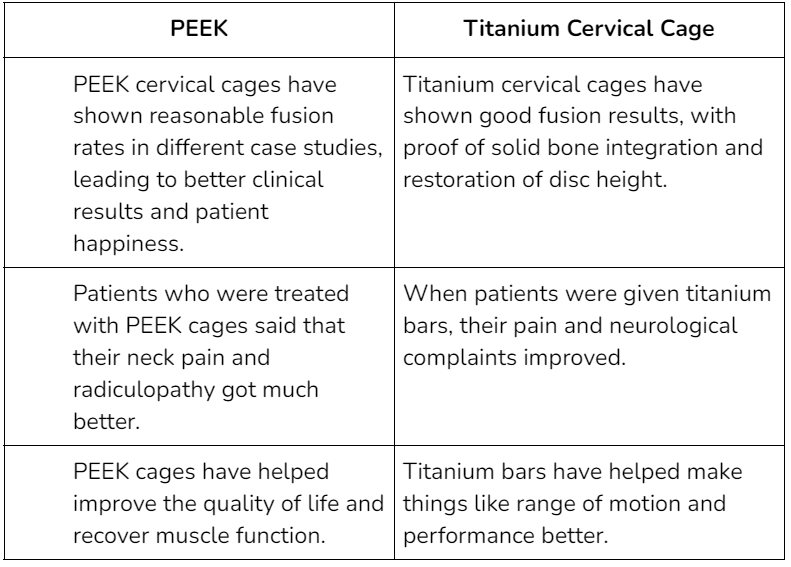 The selection of materials for cervical cages is of considerable significance within the domain of spinal fusion procedures. Polyetheretherketone (PEEK) and Titanium are two broadly used options that are frequently used. This article comprehensively examines the similarities and differences between PEEK and Titanium cervical cages, focusing on their clinical applications and the criteria that influence their choice in medical practice.
The selection of materials for cervical cages is of considerable significance within the domain of spinal fusion procedures. Polyetheretherketone (PEEK) and Titanium are two broadly used options that are frequently used. This article comprehensively examines the similarities and differences between PEEK and Titanium cervical cages, focusing on their clinical applications and the criteria that influence their choice in medical practice.
Introduction
Innovative cervical cage materials have transformed spinal surgery. Polyetheretherketone (PEEK) and Titanium have received attention for their unique properties and potential impact on patient outcomes. Biomechanical and clinical aspects determine the material choice.
This study looks at the subtle differences between PEEK and Titanium cervical cages. It tries to figure out what makes them different, their clinical effects, and what the most important factors are that surgeons look at when deciding how to best perform spinal fusion procedures.
PEEK Cervical Cages
PEEK, a synthetic polymer, has garnered significant attention as a favoured material for cervical cages in the medical field. The material’s bioinert characteristics and radiolucent features render it a highly compelling option.
PEEK cages provide a harmonious combination of mechanical qualities and bone compatibility owing to their modulus of elasticity, which closely approximates natural bone.
One significant benefit of polyetheretherketone (PEEK) is its radiolucency property, which enables unobstructed postoperative imaging. Nevertheless, it is essential to acknowledge that the osseointegration potential of PEEK may not be as substantial as alternative materials.
Titanium Cervical Cages
Titanium, a biocompatible metal, offers a durable alternative for cervical cages. Titanium cages are renowned for their notable mechanical strength and advantageous osseointegration properties, contributing to heightened stability and effective integration with adjoining bones.
Nevertheless, the radiopacity of Titanium may present difficulties in achieving precise postoperative imaging. Although Titanium’s mechanical properties differ from bone’s, it continues to be a preferred material for operations requiring significant structural support and the possibility of osseointegration.
Factors Influencing the Choice
When deciding between titanium and PEEK cervical cages, other factors must be taken into consideration.
Biocompatibility
Considering how well the material works with the organs and biological system of the body.
Radiolucency
It is a property of a material that allows clear visibility in medical imaging techniques such as X-rays.
Mechanical properties
Figuring out how strong, stiff, and long-lasting the material will support the cervical spine.
Fusion Success
Clinical success rates in the past and proof that fusion has happened with the chosen material.
Allergies or Sensitivities
Discuss any possible allergic responses or sensitivity to the material.
Implant Design
Whether or not the material is compatible with the shape and design of the neck cage.
Surgeon choice
A surgeon’s knowledge and choice of using PEEK or Titanium cages.
Revision Surgery
Consider how easy or complicated the surgery might be if it needs to be done again.
Cost
Determine how much money using a PEEK or Titanium neck cage will cost.
Patient Factors
Customizing the choice based on the patient’s age, health, and way of life.
Clinical Applications and Evidence
Several clinical studies have examined the difference between Peek and Titanium Cervical cages.
Studies have looked at how well PEEK neck guards work. Research shows that PEEK cages can increase the number of successful fusions, improve patient results, and reduce problems like dysphagia, which is when it’s hard to swallow.
PEEK cages are often used when radiolucency and biocompatibility are necessary or when the patient’s body requires mechanical support and radiographic clarity.
Research shows that titanium cervical bars work well for getting good fusion, recovering disc height, and maintaining the stability of the segments. Titanium bars are often used when mechanical strength and the ability to fuse with bone are essential or when the patient’s situation calls for a stronger implant.
Case Studies
PEEK and titanium cervical cages have both been the subject of several case studies that have been carried out to investigate the results of employing these materials in cervical fusion operations.
This research attempted to examine each material’s efficacy, benefits, and limits in terms of encouraging successful fusion, relieving pain, and improving functionality.
The findings point to favourable outcomes across the board for both PEEK and Titanium cervical cages, even though each material offers unique advantages.
Based on case studies, we have concluded the difference between Peek and Titanium Cervical Cages.
Conclusion
Both PEEK and Titanium cervical cages have their benefits, and the one used depends on the patient’s condition and the surgeon’s choice. PEEK cages are radiolucent and have the same mechanical properties as bone, while titanium cages are strong, durable, and have the potential to fuse with bone. The decision between these materials relies on things like the patient’s shape, the surgery’s goals, and the balance between mechanical support and being able to see on an X-ray. It is recommended that the patient consult with a doctor before deciding on a course of treatment.
Further any Inquiry about Spinal Implants Click here.

